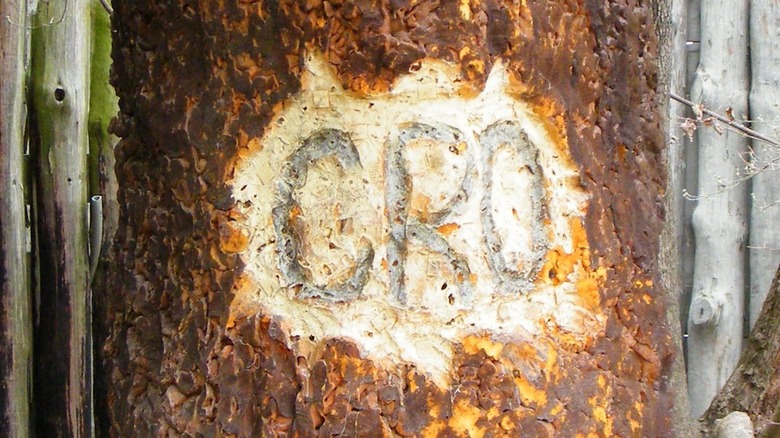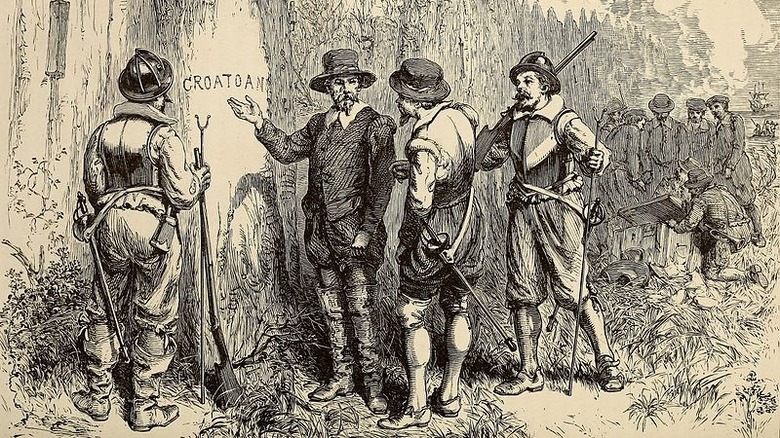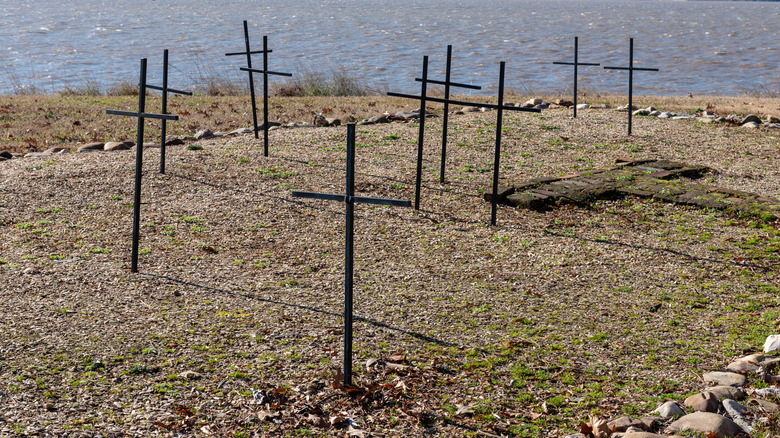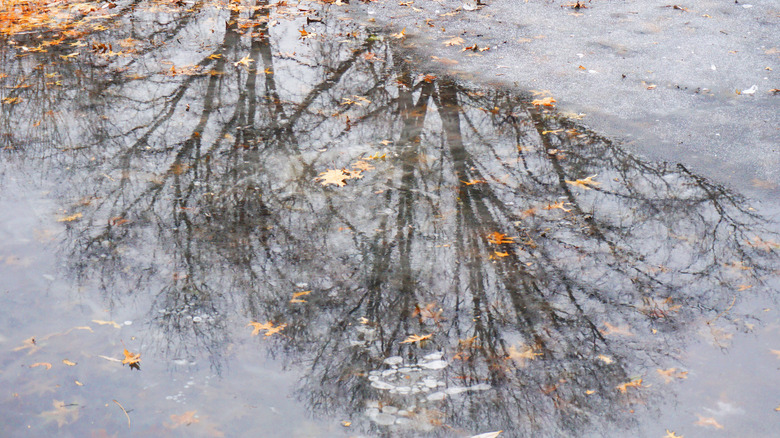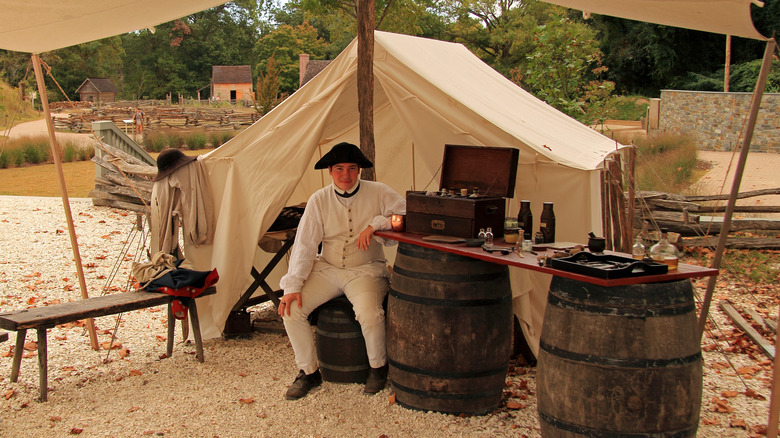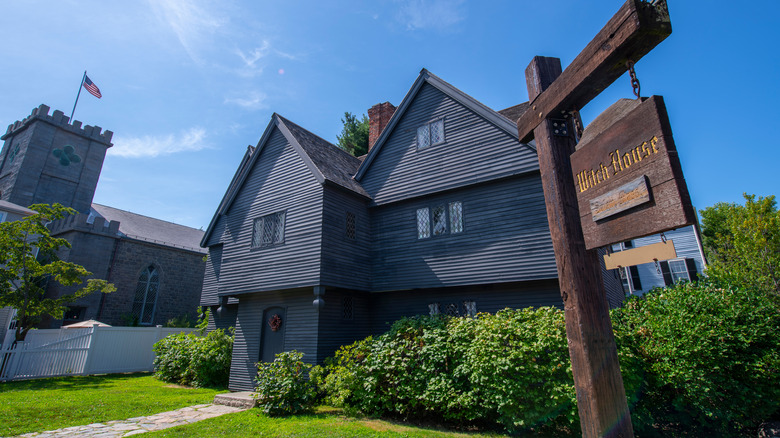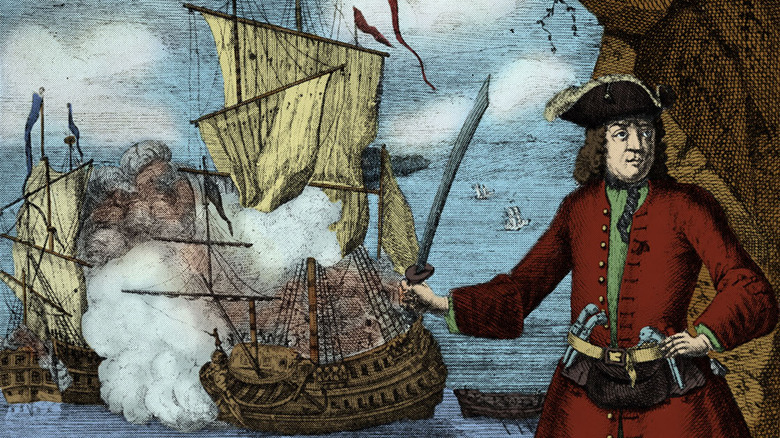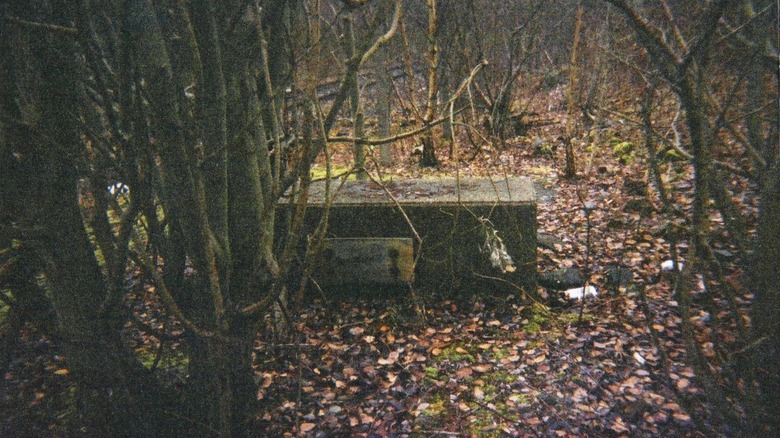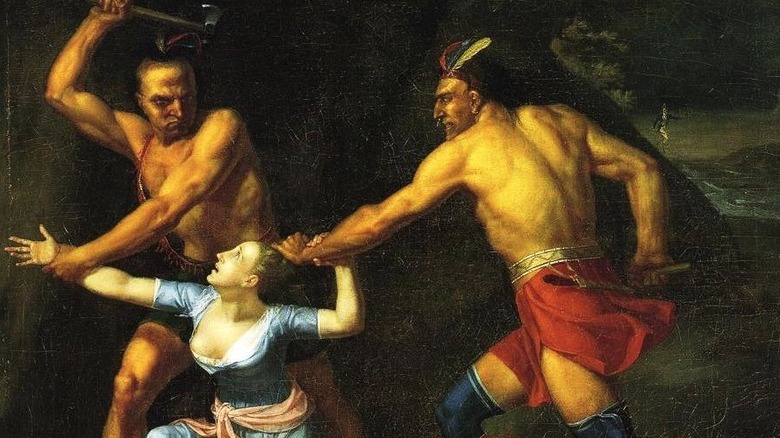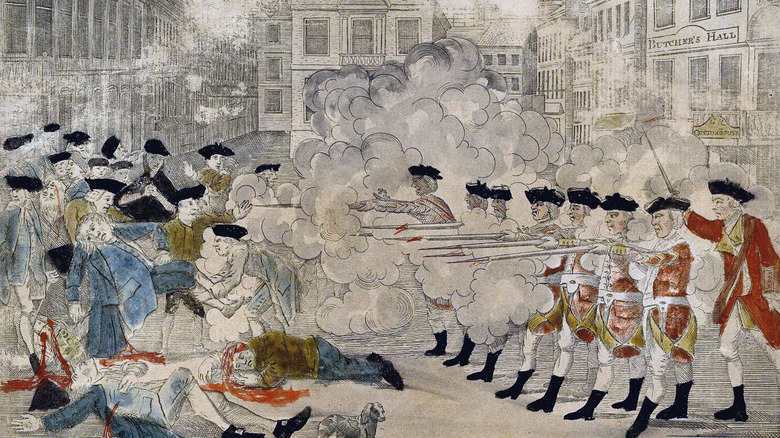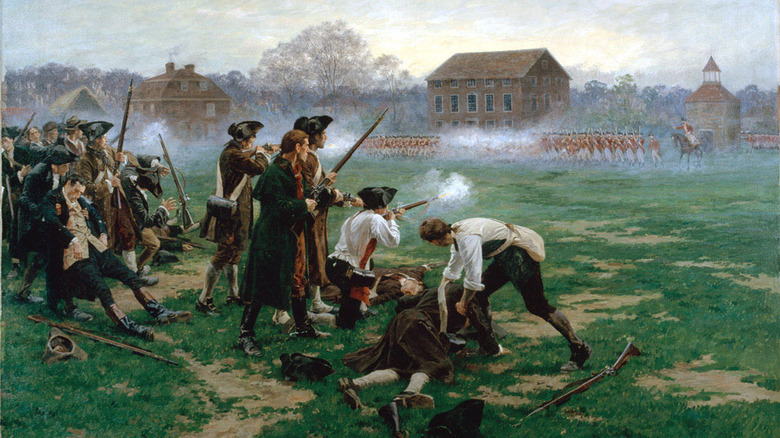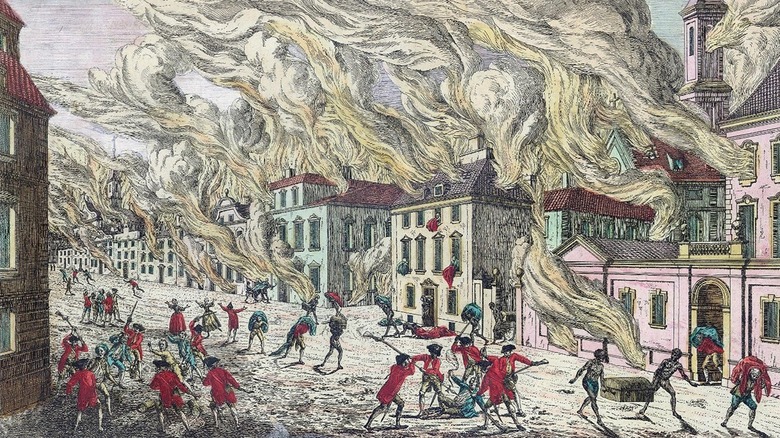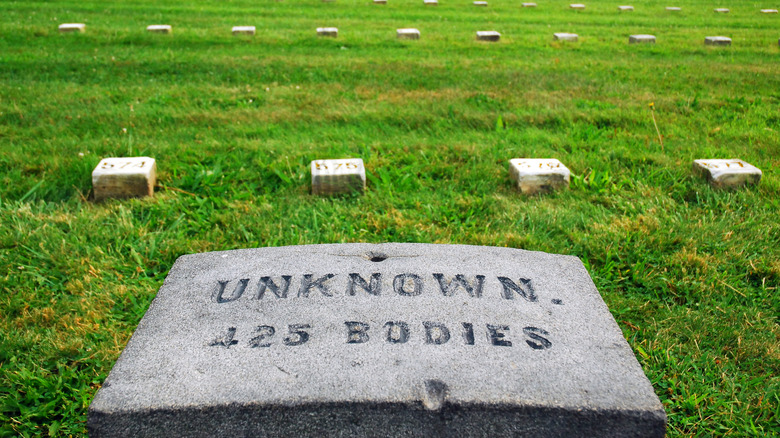Unsolved Mysteries Of Colonial America
The Colonial period of American history stretched from 1607, the year the British established the first lasting colony in the so-called New World with the founding of Jamestown, to the start of the American Revolution in 1776. It was a period full of major, world-changing events, both good and bad. You probably dozed off learning about them in high school U.S. history class.
But there are some seriously brain-bending incidences that happened at the same time as those textbook-worthy historical moments. Alongside famed events like the founding of the Plymouth colony by the Pilgrims or the Boston Tea Party were plenty of strange and unexplained happenings that remain mysteries of the Colonial period to this very day. While modern forensics and a blend of detective and archeological work can still solve some Colonial mysteries, most of these unsolved mysteries from the early days of American history will likely never be explained.
We will likely never know what happened to the lost colony of Roanoke
What happened to the entire population of the so-called Lost Colony of Roanoke? We will likely never know. But theories abound as to how this colony went from promising to vanished in just a few short years. According to History, in August of 1587, a group of about 115 English settlers established a colony on Roanoke Island, just off the coast of present-day North Carolina.
In late 1587, the governor of the Roanoke colony, a man named John White, set out on a return voyage to England in order to procure more supplies for the new settlement. If you know your history, you'll recall that in 1588 war erupted between the English and Spanish empires with the Spaniards dispatching the mighty (but ill-fated) Spanish Armada. Thus, White's return to Roanoke was delayed by years. When he finally made it back across the Atlantic, he found Roanoke in ruins and abandoned with no trace of what had caused the disappearance of its people. Were they killed by natives? Wiped out by disease or starvation, or maybe a terrible storm? The only clue was the word "Croatoan" carved into a wooden post, that being the name of a nearby island – but no answers as to what happened were found on that island or anywhere else.
While modern investigations have looked into every possible angle, there's still no one theory most historians agree on.
Why did so many Jamestown settlers die?
The settlement of Jamestown, established by English colonists in the spring of 1607 in what is now the state of Virginia, was by the main metric a success: It lasted. In fact, it would be the first permanent English settlement in the Americas and remains a population center today. But it was a Pyrrhic victory in those early years, as hundreds of the early settlers of the town would perish — as in, out of 500 Jamestown colonists who settled there by the year 1609, only about 60 were still alive by the summer of 1610. In fact, life (and death, more accurately) in Jamestown was by that point so bad that, according to PBS, on June 7th, 1610, the remaining residents abandoned their colony, but the very next day they were turned back and ordered to remain there by newly appointed governor of the colony, one Thomas West.
The mystery of the so-called "Starving Time" at the Jamestown colony is that, to this day, historians cannot quite determine why a staggering 88% of the colonists there died in those early years. Many factors likely contributed, including a horrible drought that ravaged crops, diseases both endemic to the English and newly acquired in the Americas, and attacks by the local Algonquian natives, but even these factors combined hardly explain why the attrition rate was so ghastly.
Was a UFO spotted in the skies over Massachusetts in 1639?
Perhaps today it's easier than ever to believe in UFOs (unidentified flying objects) or, as they are more properly termed, UAP (unidentified aerial phenomena) given the recent release on such sightings and occurrences by the Office of the Director of National Intelligence of the United States of America. But nearly 400 years ago, no such report was available. Thus it was that when in early 1639 three men from the Massachusetts Bay Colony were stupefied by some sort of glowing, flying object, they had no explanation to offer for what they saw, according to History.
According to journal entries recorded by the colony's governor, John Winthrop, who did not personally experience the happenings, the witnesses saw a glowing, ostensibly flaming object in the sky that "when it stood still, it flamed up, and was about three yards square ... when it ran, it was contracted into the figure of a swine." The mysterious luminescent object apparently darted to and from in the sky, moving "as swift as an arrow," and during the encounter, the three men who shared the experience found their boat had travelled nearly a mile down the Muddy River, a tributary of the tidal basin of the Charles River near Boston. And no, they weren't drunk: Governor Winthrop took pains to describe the eyewitnesses to the UAP as sober and discreet.
Who was the teenager buried in the wall of an Annapolis cellar in the 1660s?
Today, the idea of a person dying and having their body stuffed unceremoniously into the wall of a cellar and promptly forgotten is anathema to our way of thinking – there would be an investigation as to what happened, likely a trial and a conviction for the wanton treatment of the remains, if not even for a murder that led to the corpse in the first place. But in the middle years of the 17th century in the English Colonies of America, there was no such luck (or respect) for people of a certain ranking in society.
Witness the very cold case of the remains of a teenage boy found in the cellar of a house built in the 1660s near what is today the capital of Maryland, the city of Annapolis. According to the Baltimore Sun, the body recovered in the 21st century was likely hidden away in the wall of the home in the middle years of that decade. Archeologists with forensic experience are confident the young man, who was likely an indentured servant of 16 years of age and stood about 5'5", was not properly buried, but hastily interred and then literally left to rot.
This one mysterious body can serve to illustrate the harsh lives of all indentured servants in Colonial America – about half of them would perish before earning their freedom.
Why did a group of girls claim possession, leading to the Salem Witch Trials?
The Salem Witch Trials are one of the best known chapters of early American history. Or they are one of the best known of events, at any rate, if the actual details of the trials are a bit murky in the minds of many. The inspiration for numerous books, movies, and the famed play "The Crucible" (though 20th century Hollywood blacklisting was also an inspiration there), the Salem Witch Trials involved the accusations of hundreds, the trying of dozens, and the execution of 18 people found guilty of witchcraft in the form of causing demonic possession in a group of young girls, according to History.
What is not clearly understood to this day and unlikely ever to be discovered is what led the girls to begin feigning satanic possession and accusing people of witchcraft in the first place. The first "case" may well have been nothing more than misunderstood epilepsy, as in January of 1692 two girls, ages nine and 11, began having seizures and uncontrolled vocal outbursts. Soon other young girls in the community began experiencing similar symptoms which were "diagnosed" by "doctors" as caused by witchcraft but that today would more likely be attributed to a phenomenon experts call Mass Hysteria, according to Medical News Today.
Did wanted pirate Captain Henry Every escape from the Red Sea all the way to Rhode Island?
It would come to be known by many as history's first recorded global manhunt, and its subject was the feared and loathsome pirate Captain Henry Every. Every's crime – or his most recent one, at any rate – was the particularly brazen September 7, 1695 attack on the ship Ganj-i-Sawai, an attack Every led aboard his own vessel, the Fancy, while his quarry was in the Red Sea. According to the Smithsonian Magazine, the Ganj-i-Sawai was under sail on a return voyage from Mecca back to India, and being as the vessel belonged to the emperor of India, it was understandably laden with treasures, such as gold and silver, which Every and his crew happily stole.
Captain Every escaped all the way across the Atlantic Ocean and is known to have made landfall in the Bahamas after the attack, and despite being pursued across the globe by agents of the Mughal regime of India, Every was never caught. His last known whereabouts are also a mystery, though some of the captain's crew were apprehended near Ireland's coast in 1696. The recent discovery in Rhode Island of a number of 17th century coins bearing Arabic inscriptions has led scholars to believe Every made his way north from the Caribbean Sea and up the eastern coast of America, quite possibly posing as (and even acting as an actual) slave trader.
Was Dudleytown, Connecticut cursed?
A few hundred years ago, a family called the Dudleys settled in an area of the colony of Connecticut. What came to be known as Dudleytown would end up considered a cursed site and well worthy of its final fate, which was abandonment. According to Damned Connecticut, this was the little village of Dudleytown, which was founded by settlers named the Dudleys in the year 1747. The region seemed set to flourish, with its fertile farmland and a growing iron production industry, but though nearby communities would prosper, Dudleytown was doomed.
According to local historians, many members of the Dudley family itself succumbed to death at a young age, as did many others who tried to make a life in the area. An inordinate number of these deaths have been attributed to suicide, an act which, at the time, was often attributed to demonic possessions. Within a few generations of the establishment of Dudleytown many farms were failing, iron production was faltering, and more people were moving away than moving in. By the turn of the 20th century, the town had been abandoned. But to this day, many visitors to the region report the uneasy feeling of paranormal presences, and there are even occasional sightings of ghosts reported.
Was Jane McCrea murdered by Natives or accidentally killed by Patriots?
Were it not for her violent end, it's quite unlikely the world would still remember Jane McCrea at all, so ironically she lives on indefinitely in memory precisely because of her death at a young age. Just what caused that death is something of a mystery, however, despite its depiction as taking place at the hands of native warriors in an 1804 oil painting by John Vanderlyn (pictured). Jane McCrea was born in the English colony of New Jersey in the year 1752 and killed in 1777, early on in the Revolutionary War, according to Britannica.
She was a known Loyalist, opposed to the cause of American independence, and thus when captured by a group of natives fighting alongside the Patriots, McCrae was apprehended and was slated to be brought to a group of Continental soldiers in hopes of a reward. While being transported to the Americans, the classic version of the story is that two groups of her native captors began to argue over who was more deserving of the reward and, in the heat of the argument, McCrae was murdered and scalped. Another probable story is that an American soldier accidentally shot and killed the young woman as she was being chased during an escape attempt, the explanation given by several natives but disavowed at the time, according to Plymouth Magazine. An examination of her body performed more than a century later did indeed find evidence of gunshot wounds, and not tomahawk wounds, so the traditional story may well be apocryphal.
Did a snowball fight lead to the Boston Massacre?
A few things about the Boston Massacre are clear, one being that its naming was more an act of propaganda than of accurate documentation, given that only five people died in the event. Another known fact is that Crispus Attucks, a man of African descent who had formerly been enslaved and was then working as a stevedore, was the first man killed and thus he is widely considered the first casualty of the Revolutionary War, according to PBS.
What we don't know for sure is why things escalated so quickly into violence that frigid night of March 5, 1770, but some historians now believe it was on the occasion of being struck with a snowball that British Private Hugh White called for reinforcements, an act that escalated tensions between the Redcoat soldiers and the Bostonians who were out protesting unfair taxation among other grievances. As snowballs gave way to stones and clubs, several Brits opened fire, five proto-Americans were killed, and more seeds of war were sown.
Who fired 'the shot heard round the world?'
We don't know what prompted the Brits to fire during the Boston Massacre, but we know it was Redcoats who did the shooting. When it comes to the first shot fired of what would come to be known as Battles of Lexington and Concord, the first combat of the American Revolution, we will likely never know. According to History, on the morning of April 19, 1775, British troops reached the town of Lexington, New Hampshire, determined to seize a stash of weapons stored in nearby Concord. Warned by Paul Revere and other riders, several dozen Patriot soldiers were armed and ready when the Redcoats arrived.
A brief standoff ensued, and in fact the rebel militiamen were about to heed their commander's order to disperse when a single shot rang out. At once fighting commenced and in the ensuing battles, which took place in Lexington, near Concord, and then as rebels pursued the British column back toward Boston, the British took some 250 casualties to the Patriots' 90. But just who was responsible for "the shot heard round the world" remains a mystery.
Who started the Great New York City Fire of 1776?
In September of 1776, only a few short months following the Declaration of Independence, the fledgling American war effort was in a bad way. General George Washington was withdrawing his troops from New York as British commander William Howe moved his soldiers into the area, and during the withdrawal, many counseled Washington to set fire to the bustling city, thereby denying its resources to the Redcoat army. Washington is known to have rejected this idea, according to U.S. History, but nonetheless, much of the city soon would burn.
On September 21st, a fire broke out in a tavern that would soon spread to consume nearly 500 buildings. Though the fire did indeed deprive the Brits of much property, it's still not known if it was arson used for this purpose, was an accidental blaze, or if the fires were in fact started by British soldiers. In the course of the harshly conducted inquiry into the cause of the fire, one of those arrested was the Patriot spy Nathan Hale who famously (if perhaps apocryphally) said before his hanging for treason: "My only regret is that I have but one life to give for my country" (according to America's Library).
Who is buried in Bethlehem, Pennsylvania's mass graves?
We know who is buried in the mass graves near Bethlehem, Pennsylvania in a general sense: They are Americans killed during the Revolutionary War. But as for who are the specific bodies among the 500 or so interred in the soil there, we will never know. It's also something of a surprise that the site became so intertwined with the war effort in the first place, the Moravian Protestants who had settled the area being staunch pacifists, according to the Washington Times.
But in the winter of 1776-77, the hospital of Bethlehem began to be inundated with wounded soldiers and the Moravians began to help the cause in a manner in keeping with their peaceful ways: they made coffins for the war dead and buried them. Soon, there were simply too many corpses to properly inter, and mass burials began. The remains were usually placed in long trenches and then covered without markers, a practice that to this day leads to the occasional accidental unearthing of Revolutionary War casualties.
